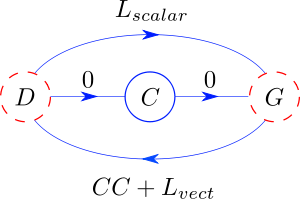Vector calculus identities
| Part of a series of articles about | ||||||
| Calculus | ||||||
|---|---|---|---|---|---|---|
|
||||||
|
||||||
|
Specialized |
||||||
The following identities are important in vector calculus:
Operator notations
Gradient
In the three-dimensional Cartesian coordinate system, the gradient of some function is given by:
where i, j, k are the standard unit vectors.
The gradient of a tensor field, , of order n, is generally written as
and is a tensor field of order n + 1. In particular, if the tensor field has order 0 (i.e. a scalar), , the resulting gradient,
is a vector field.
Divergence
In three-dimensional Cartesian coordinates, the divergence of a continuously differentiable vector field is defined as the scalar-valued function:
The divergence of a tensor field, , of non-zero order n, is generally written as
and is a contraction to a tensor field of order n − 1. Specifically, the divergence of a vector is a scalar. The divergence of a higher order tensor field may be found by decomposing the tensor field into a sum of outer products, thereby allowing the use of the identity,
where is the directional derivative in the direction of multiplied by its magnitude. Specifically, for the outer product of two vectors,
Curl
In Cartesian coordinates, for :
- curl( ) =
where i, j, and k are the unit vectors for the x-, y-, and z-axes, respectively.
For a 3-dimensional vector field
, curl is also a 3-dimensional vector field, generally written as:
or in Einstein notation as:
where ε is the Levi-Civita symbol.
Laplacian
In Cartesian coordinates, the Laplacian of a function is
For a tensor field, , the laplacian is generally written as:
and is a tensor field of the same order.
Special notations
In Feynman subscript notation,
where the notation ∇B means the subscripted gradient operates on only the factor B.[1][2]
A less general but similar idea is used in geometric algebra where the so-called Hestenes overdot notation is employed.[3] The above identity is then expressed as:
where overdots define the scope of the vector derivative. The dotted vector, in this case B, is differentiated, while the (undotted) A is held constant.
For the remainder of this article, Feynman subscript notation will be used where appropriate.
Properties
For scalar fields and , vector fields and , and cartesian functions and :
Distributive properties
Product rule for the gradient
The gradient of the product of two scalar fields and follows the same form as the product rule in single variable calculus.
Product of a scalar and a vector
Quotient rule
Chain rule
Vector dot product
where JA denotes the Jacobian of A. For more details, refer to these notes [4]
As a special case, when A = B,
Vector cross product
Second derivatives
Curl of the gradient
The curl of the gradient of any continuously twice-differentiable scalar field is always the zero vector:
Divergence of the curl
The divergence of the curl of any vector field A is always zero:
Divergence of the gradient
The Laplacian of a scalar field is the divergence of its gradient:
The result is a scalar quantity.
Curl of the curl
Here,∇2 is the vector Laplacian operating on the vector field A.
Summary of important identities
Addition and multiplication
Differentiation
Gradient
Divergence
Curl
Second derivatives

Third derivatives
Integration
Below, the curly symbol ∂ means "boundary of".
Surface–volume integrals
In the following surface–volume integral theorems, V denotes a three-dimensional volume with a corresponding two-dimensional boundary S = ∂V (a closed surface):
Curve–surface integrals
In the following curve–surface integral theorems, S denotes a 2d open surface with a corresponding 1d boundary C = ∂S (a closed curve):
Integration around a closed curve in the clockwise sense is the negative of the same line integral in the counterclockwise sense (analogous to interchanging the limits in a definite integral):
See also
References
- ↑ Feynman, R. P.; Leighton, R. B.; Sands, M. (1964). The Feynman Lectures on Physics. Addison-Wesley. Vol II, p. 27–4. ISBN 0-8053-9049-9.
- ↑ Kholmetskii, A. L.; Missevitch, O. V. (2005). "The Faraday induction law in relativity theory" (PDF). p. 4. arXiv:physics/0504223.
- ↑ Doran, C.; Lasenby, A. (2003). Geometric algebra for physicists. Cambridge University Press. p. 169. ISBN 978-0-521-71595-9.
- ↑ Kelly, P. (2013). "Chapter 1.14 Tensor Calculus 1: Tensor Fields" (PDF). Mechanics Lecture Notes Part III: Foundations of Continuum Mechanics. University of Auckland. Retrieved 7 December 2017.
Further reading
- Balanis, Constantine A. Advanced Engineering Electromagnetics. ISBN 0-471-62194-3.
- Schey, H. M. (1997). Div Grad Curl and all that: An informal text on vector calculus. W. W. Norton & Company. ISBN 0-393-96997-5.
- Griffiths, David J. (1999). Introduction to Electrodynamics. Prentice Hall. ISBN 0-13-805326-X.